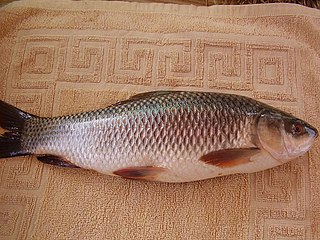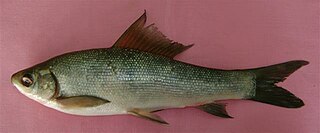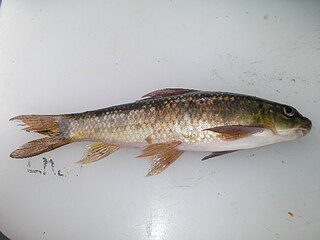
The rohu, rui, ruhi or roho labeo is a species of fish of the carp family, found in rivers in South Asia. It is a large omnivore and extensively used in aquaculture.

Catla, also known as the major South Asian carp, is an economically important South Asian freshwater fish in the carp family Cyprinidae. It is native to rivers and lakes in northern India, Bangladesh, Myanmar, Nepal, and Pakistan, but has also been introduced elsewhere in South Asia and is commonly farmed.

Labeo is a genus of carps in the family Cyprinidae. They are found in freshwater habitats in the tropics and subtropics of Africa and Asia.

The Kuria labeo is a species of fish in the carp family, Cyprinidae. It is native to Pakistan, India, Bangladesh, and Burma, and it is known from Afghanistan and Nepal.

Labeo angra is a species of fish in the family Cyprinidae, the carps and minnows. It is commonly known as the Angra labeo. It is native to Asia, where it is distributed in Bangladesh, Burma, Nepal, and Pakistan. It has also been reported from Afghanistan.

The black sharkminnow, also known as the black shark or black labeo, is a species of freshwater fish in the carp family. It is found in the Mekong and Chao Phraya river basins, Malay Peninsula, Sumatra, Java and Borneo. It can reach a length of 90 cm (3 ft) and a weight of 7 kg (15 lb). It is sometimes seen in the aquarium trade, but is generally unsuitable for home aquaria due to its large adult size and territorial, aggressive behavior.

Labeo coubie, the African carp, is a cyprinid fish, widespread in Africa, where it occurs within the drainage basin of the Nile and in the Chad, Niger-Benue, Volta, Senegal and Gambia Rivers, as well as the Cross River and Cameroon coastal rivers. Furthermore, it is also known from East Africa and the middle reaches of the Congo. Records from the Zambezi drainage need confirmation.
Labeo curchius is fish in genus Labeo. It is endemic to the Salween basin in Asia, as indicated by Fishbase, but it was originally described from specimens taken from the Ganges and the source used by Fishbase does not state this species is endemic to the Salween but that it is present in that basin. The taxonomic status of L. curchius is uncertain and it may be a domesticated variety of Labeo gonius.

Labeo dyocheilus is fish in genus Labeo from southern Asia.
Labeo forskalii is fish in genus Labeo from Northeast and East Africa. The maximum total length of the species is 36 cm (14 in). It is under heavy fishing pressure in Uganda.
Gregori's labeo is fish in genus Labeo. It is found in the Tana and Galana Rivers in Kenya and Tanzania. IUCN reports it also from Juba, Somalia, and does not include Tanzania in the distribution area.
Labeo indramontri is fish in genus Labeo from the Chao Praya and Mekong rivers on south-east Asia.
Labeo lukulae, the red-spot mudsucker, is a species of freshwater cyprinid fish in the genus Labeo. It is found in western Africa from Cameroon south to Angola. It is exploited for human consumption.

The Nile carp is a fish species in the genus Labeo. It feeds primary on plankton, and is distributed along the entire Nile valley. It is generally believed to be the fish that swallowed the phallus of the Egyptian god Osiris in the myth regarding his death at the hands of his brother Seth.
Labeo senegalensis is a species of freshwater ray-finned fish in the genus Labeo from West Africa.

The redeye labeo is a species of fish in the cyprinid genus Labeo. It is a freshwater fish endemic to the rivers of East Africa, from the Zambezi through the Limpopo and Komati Rivers to the Pongola River. It also inhabits upper and middle parts of the Congo River.

Boggut labeo or the minor carp is an Asian freshwater fish of the family Cyprinidae. It is known from Pakistan, India and Bangladesh.
Labeo nigrescens is a species of freshwater fish belonging to the genus Labeo. It is endemic to Karnataka in India. It is sometimes considered conspecific with Labeo calbasu.
Hail Haor Wildlife Sanctuary is a major wildlife sanctuary in Bangladesh. It is one of the most important wetlands in the Sylhet Basin for the resident and migratory waterfowls. It is also important watersource for the inhabitants living around when all other sources dry up during summer. The sanctuary is located in Moulvibazar District, in the northeast region of the country.












